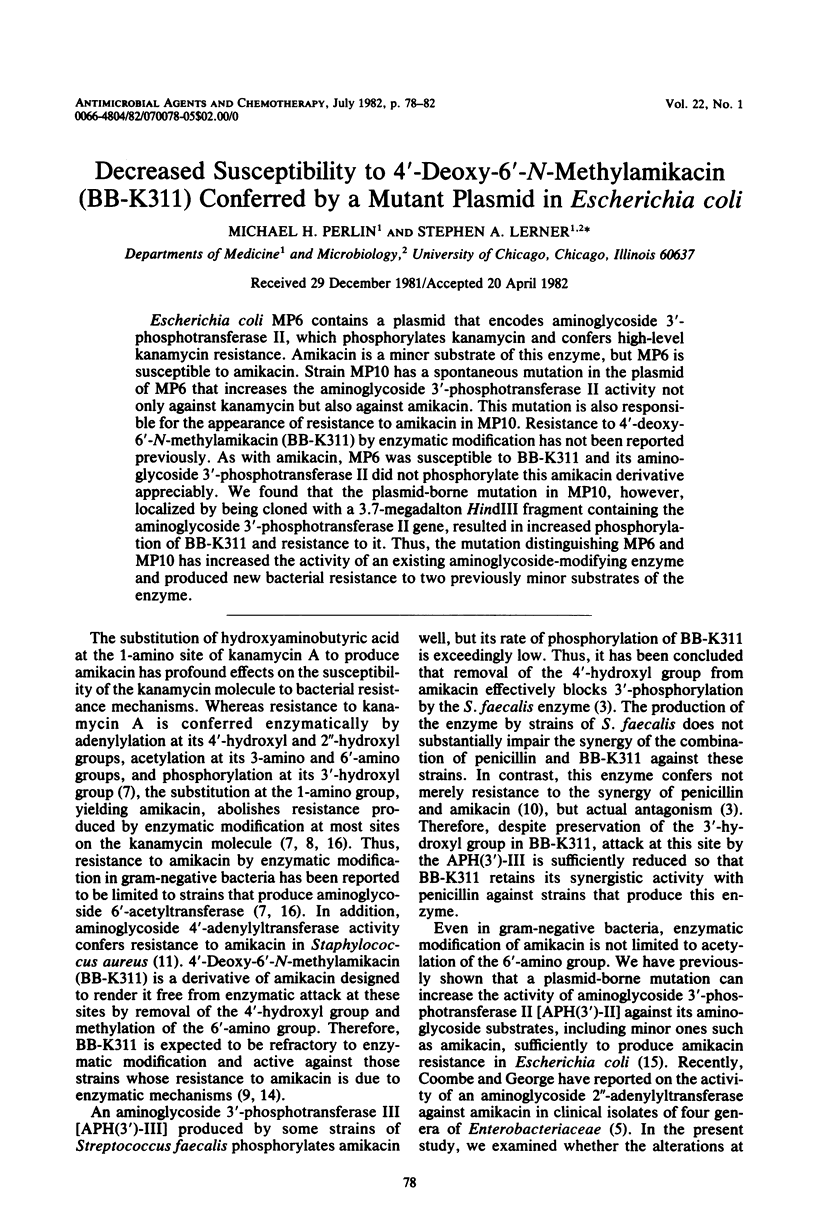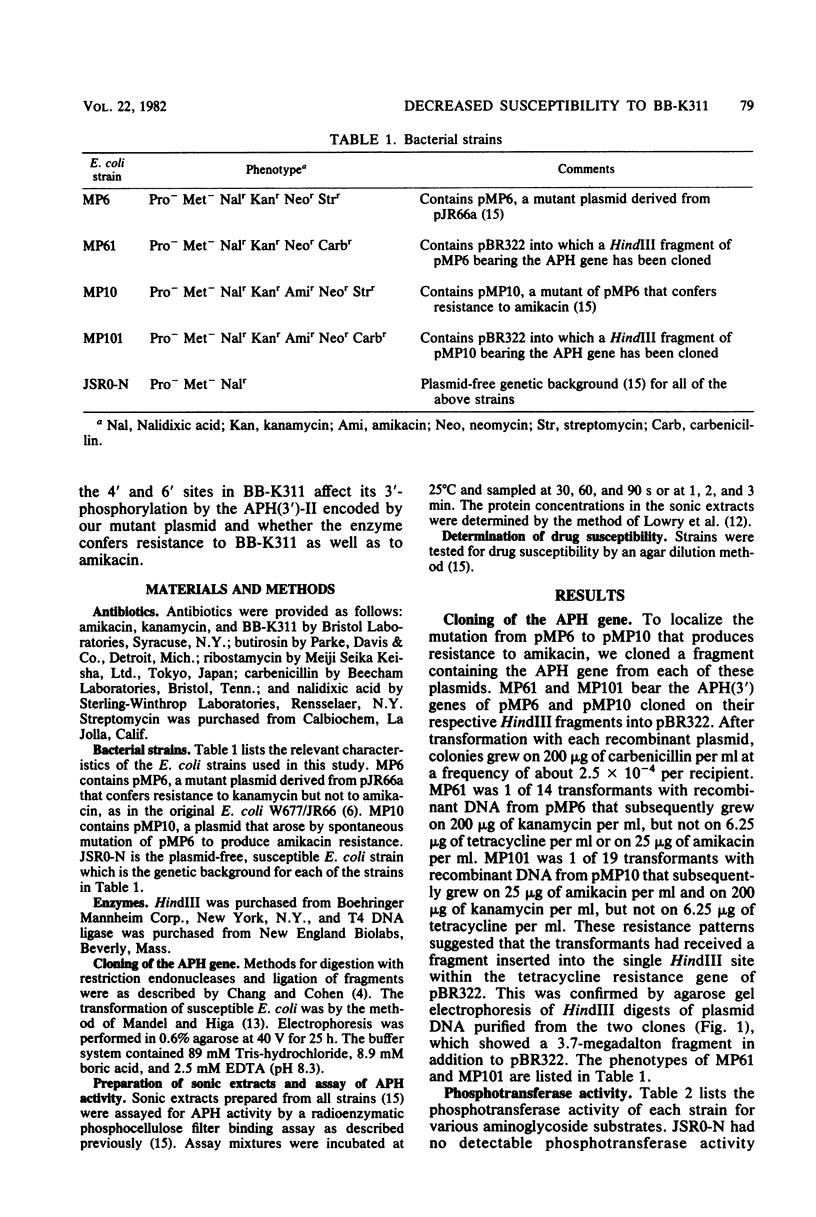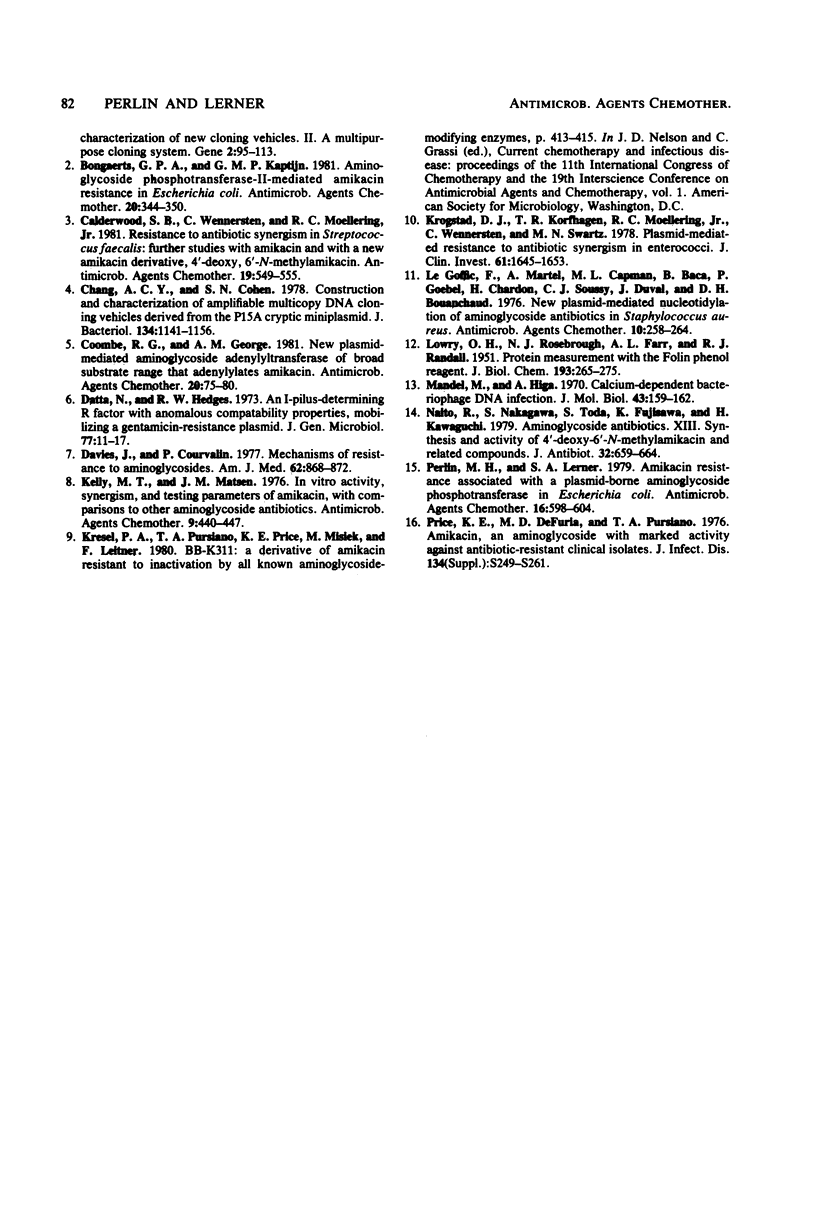Abstract
Escherichia coli MP6 contains a plasmid that encodes aminoglycoside 3'-phosphotransferase II, which phosphorylates kanamycin and confers high-level kanamycin resistance, Amikacin is a minor substrate of this enzyme, but MP6 is susceptible to amikacin. Strain MP10 has a spontaneous mutation in the plasmid of MP6 that increases the aminoglycoside 3'-phosphotransferase II activity not only against kanamycin but also against amikacin. This mutation is also responsible for the appearance of resistance to amikacin in MP10. Resistance to 4'-deoxy-6'-N-methylamikacin (BB-K311) by enzymatic modification has not been reported previously. As with amikacin, MP6 was susceptible to BB-K311 and its aminoglycoside 3'-phosphotransferase II did not phosphorylate this amikacin derivative appreciably. We found that the plasmid-borne mutation in MP10, however, localized by being cloned with a 3.7-megadalton HindIII fragment containing the aminoglycoside 3'-phosphotransferase II gene, resulted in increased phosphorylation of BB-K311 and resistance to it. Thus, the mutation distinguishing MP6 and MP10 has increased the activity of an existing aminoglycoside-modifying enzyme and produced new bacterial resistance to two previously minor substrates of the enzyme.
Full text
PDF




Images in this article
Selected References
These references are in PubMed. This may not be the complete list of references from this article.
- Bongaerts G. P., Kaptijn G. M. Aminoglycoside phosphotransferase-II-mediated amikacin resistance in Escherichia coli. Antimicrob Agents Chemother. 1981 Sep;20(3):344–350. doi: 10.1128/aac.20.3.344. [DOI] [PMC free article] [PubMed] [Google Scholar]
- Calderwood S. B., Wennersten C., Moellering R. C., Jr Resistance to antibiotic synergism in Streptococcus faecalis: further studies with amikacin and with a new amikacin derivative, 4'-deoxy, 6'-N-methylamikacin. Antimicrob Agents Chemother. 1981 Apr;19(4):549–555. doi: 10.1128/aac.19.4.549. [DOI] [PMC free article] [PubMed] [Google Scholar]
- Chang A. C., Cohen S. N. Construction and characterization of amplifiable multicopy DNA cloning vehicles derived from the P15A cryptic miniplasmid. J Bacteriol. 1978 Jun;134(3):1141–1156. doi: 10.1128/jb.134.3.1141-1156.1978. [DOI] [PMC free article] [PubMed] [Google Scholar]
- Coombe R. G., George A. M. New plasmid-mediated aminoglycoside adenylyltransferase of broad substrate range that adenylylates amikacin. Antimicrob Agents Chemother. 1981 Jul;20(1):75–80. doi: 10.1128/aac.20.1.75. [DOI] [PMC free article] [PubMed] [Google Scholar]
- Datta N., Hedges R. W. An I pilus-determining R factor with anomalous compatibility properties, mobilizing a gentamicin-resistance plasmid. J Gen Microbiol. 1973 Jul;77(1):11–17. doi: 10.1099/00221287-77-1-11. [DOI] [PubMed] [Google Scholar]
- Davies J., Courvalin P. Mechanisms of resistance to aminoglycosides. Am J Med. 1977 Jun;62(6):868–872. doi: 10.1016/0002-9343(77)90654-4. [DOI] [PubMed] [Google Scholar]
- Kelly M. T., Matsen J. M. In vitro activity, synergism, and testing parameters of amikacin, with comparisons to other aminoglycoside antibiotics. Antimicrob Agents Chemother. 1976 Mar;9(3):440–447. doi: 10.1128/aac.9.3.440. [DOI] [PMC free article] [PubMed] [Google Scholar]
- Krogstad D. J., Korfhagen T. R., Moellering R. C., Jr, Wennersten C., Swartz M. N. Plasmid-mediated resistance to antibiotic synergism in enterococci. J Clin Invest. 1978 Jun;61(6):1645–1653. doi: 10.1172/JCI109085. [DOI] [PMC free article] [PubMed] [Google Scholar]
- LOWRY O. H., ROSEBROUGH N. J., FARR A. L., RANDALL R. J. Protein measurement with the Folin phenol reagent. J Biol Chem. 1951 Nov;193(1):265–275. [PubMed] [Google Scholar]
- Le Goffic F., Martel A., Capmau M. L., Baca B., Goebel P., Chardon H., Soussy C. J., Duval J., Bouanchaud D. H. New plasmid-mediated nucleotidylation of aminoglycoside antibiotics in Staphlococcus aureus. Antimicrob Agents Chemother. 1976 Aug;10(2):258–264. doi: 10.1128/aac.10.2.258. [DOI] [PMC free article] [PubMed] [Google Scholar]
- Mandel M., Higa A. Calcium-dependent bacteriophage DNA infection. J Mol Biol. 1970 Oct 14;53(1):159–162. doi: 10.1016/0022-2836(70)90051-3. [DOI] [PubMed] [Google Scholar]
- Naito T., Nakagawa S., Toda S., Fujisawa K., Kawaguchi H. Aminoglycoside antibiotics. XIII. Synthesis and activity of 4-deoxy-6'-n-methylamikacin and related compounds. J Antibiot (Tokyo) 1979 Jun;32(6):659–664. doi: 10.7164/antibiotics.32.659. [DOI] [PubMed] [Google Scholar]
- Perlin M. H., Lerner S. A. Amikacin resistance associated with a plasmid-borne aminoglycoside phosphotransferase in Escherichia coli. Antimicrob Agents Chemother. 1979 Nov;16(5):598–604. doi: 10.1128/aac.16.5.598. [DOI] [PMC free article] [PubMed] [Google Scholar]
- Price K. E., DeFuria M. D., Pursiano T. A. Amikacin, an aminoglycoside with marked activity against antibiotic-resistant clinical isolates. J Infect Dis. 1976 Nov;134(Suppl):S249–S261. doi: 10.1093/infdis/135.supplement_2.s249. [DOI] [PubMed] [Google Scholar]



